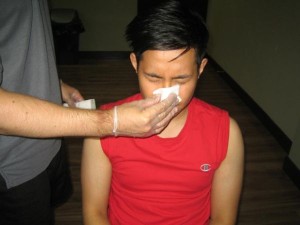A scraped, bloody nose on a crying toddler can be alarming, but in most cases there is no need to worry. Even though a scraped nose can sting and bleed, this injury is rarely serious and only involves the upper surface of the skin. A scraped nose is considered common among toddlers and young children, usually as a result of falls or other minor accidents. Correct care of a scraped nose helps reduce the pain as well as the risk for infection and even prevent scarring.
What to do for a scraped nose
Once a child ends up with a scraped nose, the following measures must be followed to promote proper healing as well as prevent the risk for infections.

- Hold down on the scraped nose using a clean cloth with gentle pressure. This will help control the bleeding. Take note that severe bleeding, extensive damage to the tissues or indications of a broken nose requires immediate medical care.
- Cleanse the scraped nose using mild soap and warm water. Carefully assess the wound for any dirt and debris and take them out using tweezers or by flushing using water. Do not leave any splinters, dirt or other debris within the wound or the individual is at risk for infection. Avoid washing any scrapes using iodine, alcohol or peroxide since these can slow down the healing process and even cause damage to the skin tissues.
- Apply a topical antibiotic on the scraped nose of the toddler in order to prevent infection. The wound should be covered with bandage or even non-stick sterile gauze.
- Always keep the wound properly covered as much as possible if the toddler tries to pick on his/her nose or remove the scab. Take note that these scabs are responsible for protecting the scrapes as well as allow the skin to heal. The scabs usually fall out within 1-2 weeks. Remember that picking on the scab can delay the healing process or lead to scarring.
- Make sure that the bandage of the toddler is changed regularly once it becomes wet, soiled or bloody. Always report any bleeding that continues after 24 hours to the doctor. The bandage should be checked for stained or malodorous drainage that can indicate that there is an infection.
It is best to schedule an appointment with a doctor if the scraped nose of the toddler does not appear to heal after 2-3 days or if there is an increase in the swelling, redness or itchiness. A doctor should be consulted right away if the toddler has not received a tetanus vaccine.
With the help of these care measures, you can easily manage a scraped nose properly to minimize the risk for infection as well as prevent any complications from developing. If the injury does not seem to heal, it is best to consult a doctor for proper assessment of the condition.
